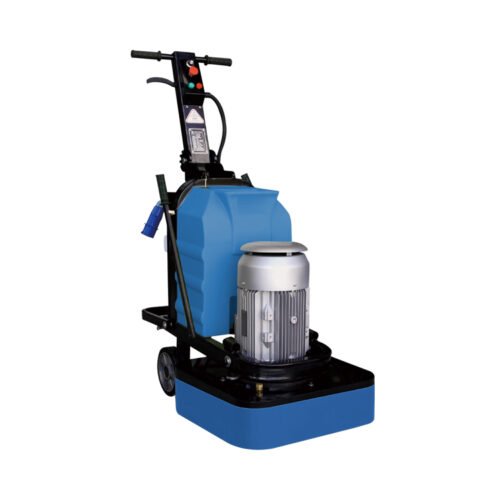WELCOME TO KINGHOME
Get A Free Quote
We will get back to you within 8 hours












Professional floor grinder machines deliver precision surface preparation, polishing, and restoration for commercial stone and concrete applications. These machines remove coatings, level uneven surfaces, and create mirror finishes on marble, granite, terrazzo, and hardened concrete floors through rotating abrasive discs loaded with diamond segments or polishing pads. KingHome offers planetary and rotary grinder configurations from established manufacturers including Revontulet, Klindex, and Kärcher, engineered for continuous commercial operation in hospitality, retail, healthcare, and institutional facilities.
Floor grinder specifications determine performance capacity and application suitability. Planetary systems feature multiple counter-rotating satellite heads (typically 3-6 discs) mounted on a main rotating plate, delivering balanced grinding motion with easier operator control and reduced fatigue during extended polishing operations. Single-disc and dual-disc rotary grinders generate higher torque for aggressive coating removal and heavy surface preparation, typically processing 200-400 square feet per hour depending on grinding depth and diamond tooling selection. Machine horsepower ranges from 1.5 HP for compact edge grinders to 20+ HP for large production units, with grinding widths spanning 10 inches to 36 inches based on project scale requirements.
Commercial floor grinding applications include epoxy coating removal, concrete surface profiling for overlay systems, marble and granite restoration, terrazzo honing, and decorative concrete polishing. Wet grinding capabilities minimize airborne silica dust and extend diamond tooling life, while dry grinding with vacuum dust collection systems enables faster material removal rates in well-ventilated spaces. Variable speed controls allow operators to adjust disc rotation (typically 175-1750 RPM) to match stone hardness, existing surface conditions, and desired finish levels from aggressive grinding to fine polishing.
Equipment selection requires matching machine weight, power requirements, and grinding head configuration to specific project demands. Lighter planetary grinders (250-600 lbs) offer superior maneuverability for smaller areas and detailed edgework, while heavier rotary systems (800-1500 lbs) provide downward pressure needed for efficient coating removal and concrete flattening on large commercial floors. Electric models operate on standard 110V household circuits or dedicated 220V/3-phase industrial power, with propane and gas engine alternatives available for outdoor applications or locations without electrical infrastructure. KingHome provides technical consultation, replacement grinding discs, polishing pads, and maintenance support to ensure optimal machine performance throughout equipment lifecycle.
GET IN TOUCH
A: Planetary grinders use multiple counter-rotating satellite heads for balanced, easier-to-control operation ideal for polishing and fine finishing work. Rotary single-disc or dual-disc grinders deliver higher torque and more robust drive systems for aggressive coating removal and heavy surface preparation, processing concrete and stone more efficiently when substantial material removal is required. Planetary systems have shorter operator learning curves and excel at precision polishing, while rotary machines handle thick adhesives and coatings more effectively.
A: Match grinding width to project scale—10-12 inch grinders suit tight spaces, corridors, and edge work, while 20-36 inch machines maximize productivity on large open floors. Consider coverage rates: compact grinders process 200-250 sq ft/hour, mid-sized units handle 400-600 sq ft/hour, and large production grinders exceed 1000 sq ft/hour. Evaluate doorway access (standard 36-inch clearance), available electrical service (110V vs 220V/3-phase), and required portability between floors or buildings.
A: Daily cleaning removes stone dust and debris from grinding heads, shrouds, and vacuum ports to maintain optimal performance. Weekly inspections check drive belts for proper tension and wear, examine diamond segments or pads for replacement needs, and verify vacuum hose connections. Monthly lubrication of motor bearings and moving parts according to manufacturer specifications prevents premature wear, while annual professional servicing addresses drive system components, electrical connections, and safety mechanisms.
A: Yes, professional grinder machines handle marble, granite, terrazzo, and concrete by changing diamond tooling grit and adjusting machine speed settings. Softer stones like marble require lower RPM speeds (175-300) and finer diamond grits to prevent surface damage, while harder concrete surfaces need higher speeds (800-1750 RPM) and more aggressive diamond segments for efficient grinding. Wet grinding mode protects heat-sensitive marble from thermal stress and produces smoother finishes on natural stone.
A: Diamond grinding segments in varying grits (coarse 16-30, medium 50-100, fine 200-400) handle surface removal, leveling, and initial polishing stages. Resin-bonded polishing pads in progressive grits (400-3000) create refined finishes on stone surfaces, while cup wheels and grinding plates with carbide or PCD (polycrystalline diamond) segments remove thick coatings, mastics, and epoxies. Magnetic quick-change systems enable rapid tooling switches between grinding and polishing operations without manual fastener adjustment.